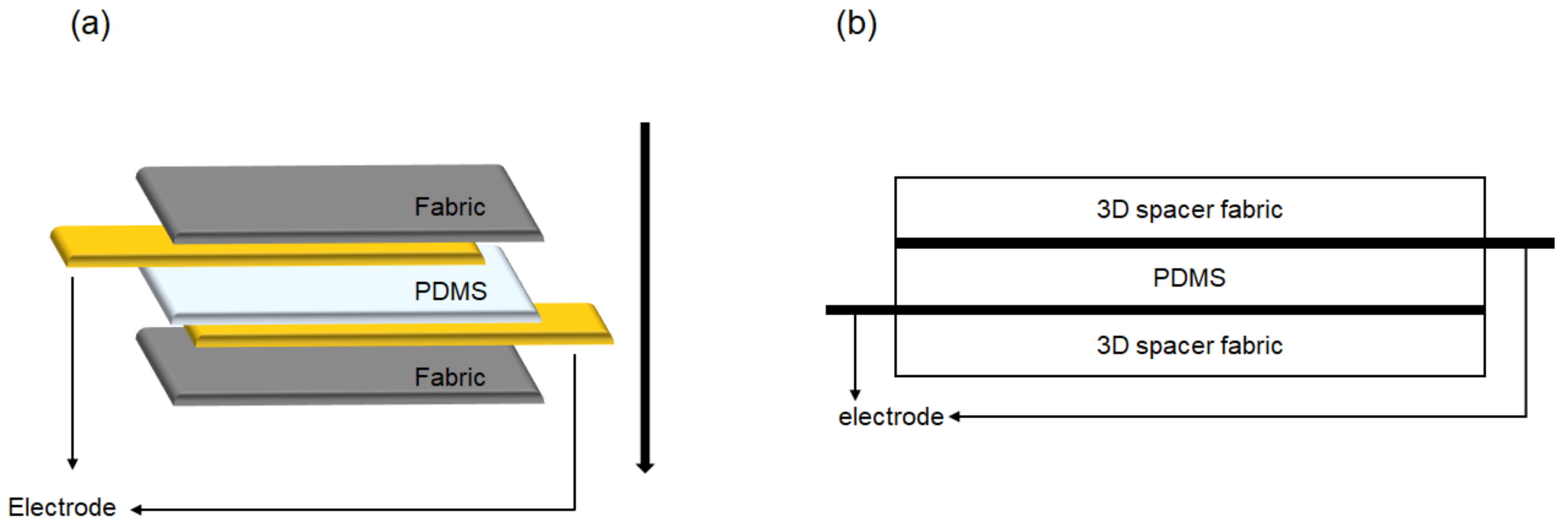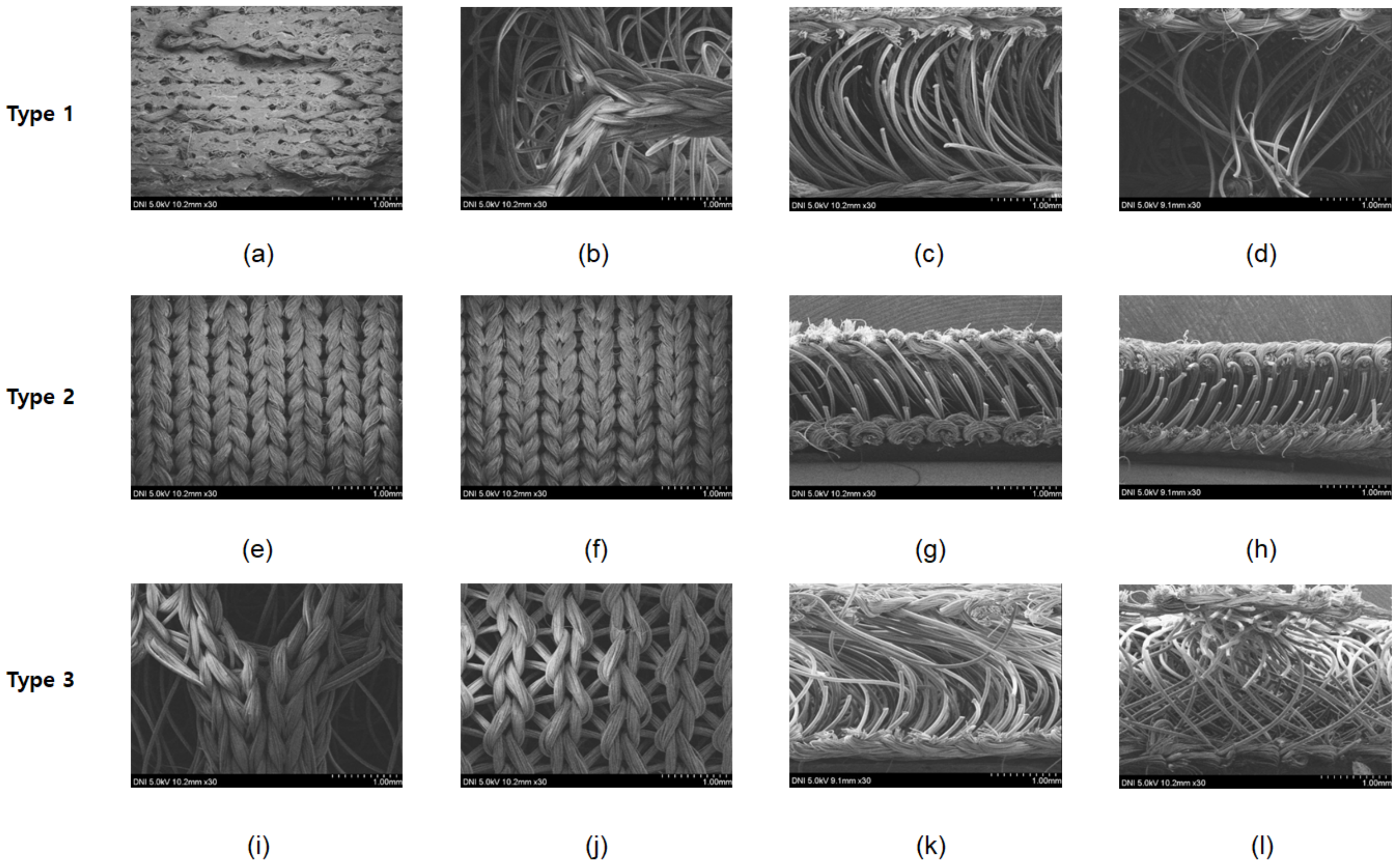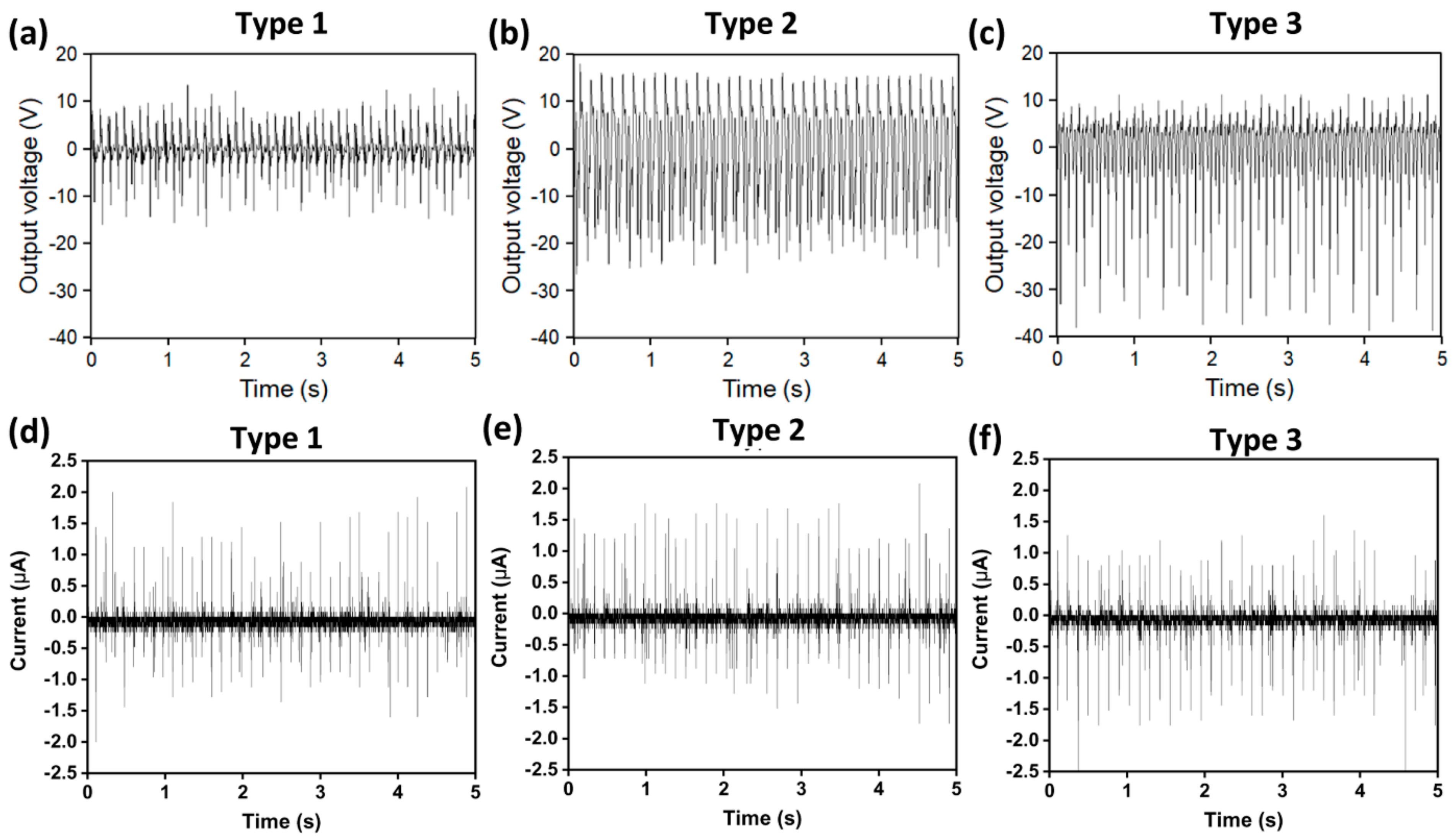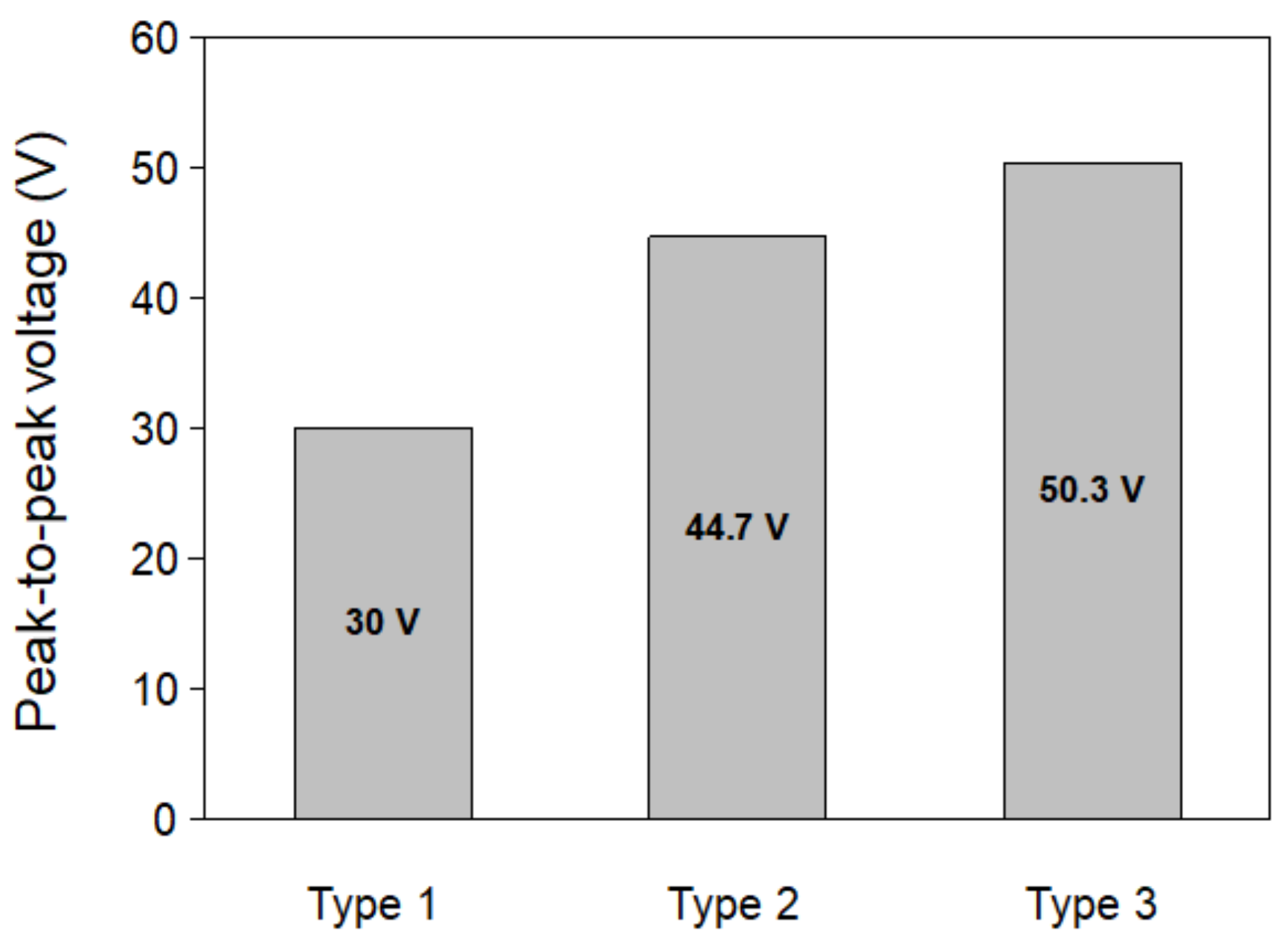Textile Triboelectric Nanogenerators with Diverse 3D-Spacer Fabrics for Improved Output Voltage
Abstract
1. Introduction
2. Materials and Methods
3. Results and Discussion
4. Conclusions
Author Contributions
Funding
Conflicts of Interest
References
- Harne, R.L.; Wang, K.W. A review of the recent research on vibration energy harvesting via bistable systems. Smart Mater. Struct. 2013, 22, 023001. [Google Scholar] [CrossRef]
- Lee, M.; Chen, C.Y.; Wang, S.; Cha, S.N.; Park, Y.J.; Kim, J.M.; Chou, L.J.; Wang, Z.L. A hybrid piezoelectric structure for wearable nanogenerators. Adv. Mater. 2012, 24, 1759–1764. [Google Scholar] [CrossRef] [PubMed]
- Parida, B.; Iniyan, S.; Goic, R. A review of solar photovoltaic technologies. Renew. Sustain. Energy Rev. 2011, 15, 1625–1636. [Google Scholar] [CrossRef]
- Vincent, P.; Shin, S.C.; Goo, J.S.; You, Y.J.; Cho, B.; Lee, S.; Lee, D.W.; Kwon, S.R.; Chung, K.B.; Lee, J.J.; et al. Indoor-type photovoltaics with organic solar cells through optimal design. Dyes Pigment. 2018, 159, 306–313. [Google Scholar] [CrossRef]
- Jung, S.; Lee, J.; Hyeon, T.; Lee, M.; Kim, D.H. Fabric-based integrated energy devices for wearable activity monitors. Adv. Mater. 2014, 26, 6329–6334. [Google Scholar] [CrossRef] [PubMed]
- Lorussi, F.; Rocchia, W.; Scilingo, E.P.; Tognetti, A.; de Rossi, D. Wearable, redundant fabric-based sensor arrays for reconstruction of body segment posture. IEEE Sens. J. 2004, 4, 807–818. [Google Scholar] [CrossRef]
- Zhang, M.; Gao, T.; Wang, J.; Liao, J.; Qiu, Y.; Yang, Q.; Xue, H.; Shi, Z.; Zhao, Y.; Xiong, Z.; et al. A hybrid fibers based wearable fabric piezoelectric nanogenerator for energy harvesting application. Nano Energy 2015, 13, 298–305. [Google Scholar] [CrossRef]
- Kwak, S.S.; Kim, H.; Seung, W.; Kim, J.; Hinchet, R.; Kim, S.W. Fully stretchable textile triboelectric nanogenerator with knitted fabric structures. ACS Nano 2017, 11, 10733–10741. [Google Scholar] [CrossRef] [PubMed]
- Chen, C.; Chen, L.; Wu, Z.; Guo, H.; Yu, W.; Du, Z.; Wang, Z.L. 3D double-faced interlock fabric triboelectric nanogenerator for bio-motion energy harvesting and as self-powered stretching and 3D tactile sensors. Mater. Today 2020, 32, 84–93. [Google Scholar] [CrossRef]
- Wang, Z.L. Triboelectric nanogenerators as new energy technology for self-powered systems and as active mechanical and chemical sensors. ACS Nano 2013, 7, 9533–9557. [Google Scholar] [CrossRef] [PubMed]
- Pu, X.; Li, L.; Liu, M.; Jiang, C.; Du, C.; Zhao, Z.; Hu, W.; Wang, Z.L. Wearable self-charging power textile based on flexible yarn supercapacitors and fabric nanogenerators. Adv. Mater. 2016, 28, 98–105. [Google Scholar] [CrossRef] [PubMed]
- Zhou, T.; Zhang, C.; Han, C.B.; Fan, F.R.; Tang, W.; Wang, Z.L. Woven structured triboelectric nanogenerator for wearble devices. ACS Appl. Mater. Interfaces 2014, 6, 14695–14701. [Google Scholar] [CrossRef] [PubMed]
- Wu, C.; Kim, T.W.; Li, F.; Guo, T. Wearable electricity generators fabricated utilizing transparent electronic textiles based on polyester/Ag nanowires/graphene core—Shell nanocomposites. ACS Nano 2016, 10, 6449–6457. [Google Scholar] [CrossRef] [PubMed]
- Soin, N.; Shah, T.H.; Anand, S.C.; Geng, J.; Pornwannachai, W.; Mandal, P.; Reid, D.; Sharma, S.; Hadimani, R.L.; Bayramol, D.V.; et al. Novel “3-D spacer” all fibre piezoelectric textiles for energy harvesting applications. Energy Environ. Sci. 2014, 7, 1670–1679. [Google Scholar] [CrossRef]
- Jeon, S.B.; Park, S.J.; Kim, W.G.; Tcho, I.W.; Jin, I.K.; Han, J.K.; Kim, D.; Choi, Y.K. Self-powered wearable keyboard with fabric based triboelectric nanogenerator. Nano Energy 2018, 53, 596–603. [Google Scholar] [CrossRef]
- El-Kashouti, M.; Elhadad, S.; Abdel-Zaher, K. Printing technology on textile fibers. J. Text. Color. Polym. Sci. 2019, 16, 129–138. [Google Scholar]
- Kim, D.K.; Jeong, J.B.; Lim, K.; Ko, J.; Lang, P.; Choi, M.; Lee, S.; Bae, J.H.; Kim, H. Improved output voltage of a nonagenerator with 3D fabric. J. Nanosci. Nanotechnol. 2020, 20, 4666–4670. [Google Scholar] [CrossRef] [PubMed]
- Marmarali, A.B. Dimensional and physical properties of cotton/spandex single jersey fabrics. Text. Res. J. 2003, 73, 11–14. [Google Scholar] [CrossRef]
- Dabiryan, H.; Jeddi, A.A.; Rastgoo, A. Analysis of warp-knitted fabric structure. Part II: Theoretical study on initial modulus of warp-knitted fabrics (tricot, locknit, and satin). J. Text. Inst. 2012, 103, 997–1011. [Google Scholar] [CrossRef]
- Park, S.; Kim, J.; Park, C.H. Analysis of the wetting state of super-repellent fabrics with liquids of varying surface tension. RSC Adv. 2016, 6, 45884. [Google Scholar] [CrossRef][Green Version]





| Fabric | Surface | Apparent Contac Angle (°) | Young’s Contact Angle (°) | Roughness Factor (rf) |
|---|---|---|---|---|
| Type 1 | Front | 84.37 | 82.4 | 0.97 |
| Back | - | - | - | |
| Type 2 | Front | 80.21 | 77.25 | 0.96 |
| Back | 79.63 | 75.24 | 0.93 | |
| Type 3 | Front | 76.99 | 70.58 | 0.93 |
| Back | 72.72 | 64.62 | 0.90 |
Publisher’s Note: MDPI stays neutral with regard to jurisdictional claims in published maps and institutional affiliations. |
© 2021 by the authors. Licensee MDPI, Basel, Switzerland. This article is an open access article distributed under the terms and conditions of the Creative Commons Attribution (CC BY) license (https://creativecommons.org/licenses/by/4.0/).
Share and Cite
Kwon, D.-H.; Kwon, J.-H.; Jeong, J.; Lee, Y.; Biswas, S.; Lee, D.-W.; Lee, S.; Bae, J.-H.; Kim, H. Textile Triboelectric Nanogenerators with Diverse 3D-Spacer Fabrics for Improved Output Voltage. Electronics 2021, 10, 937. https://doi.org/10.3390/electronics10080937
Kwon D-H, Kwon J-H, Jeong J, Lee Y, Biswas S, Lee D-W, Lee S, Bae J-H, Kim H. Textile Triboelectric Nanogenerators with Diverse 3D-Spacer Fabrics for Improved Output Voltage. Electronics. 2021; 10(8):937. https://doi.org/10.3390/electronics10080937
Chicago/Turabian StyleKwon, Dae-Hyeon, Jin-Hyuk Kwon, Jaebum Jeong, Youngju Lee, Swarup Biswas, Dong-Wook Lee, Sohee Lee, Jin-Hyuk Bae, and Hyeok Kim. 2021. "Textile Triboelectric Nanogenerators with Diverse 3D-Spacer Fabrics for Improved Output Voltage" Electronics 10, no. 8: 937. https://doi.org/10.3390/electronics10080937
APA StyleKwon, D.-H., Kwon, J.-H., Jeong, J., Lee, Y., Biswas, S., Lee, D.-W., Lee, S., Bae, J.-H., & Kim, H. (2021). Textile Triboelectric Nanogenerators with Diverse 3D-Spacer Fabrics for Improved Output Voltage. Electronics, 10(8), 937. https://doi.org/10.3390/electronics10080937








